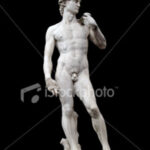The renaissance is known by historians and students alike all over the world as a period of rebirth for Europe. This “rebirth” extended its branches to all aspects of European life, especially art such as sculptors, architecture, and paintings. One of the most influential paintings of all time is ‘The Creation of Adam,’ painted by Michelangelo Buonarroti in the early 16th century on the ceiling of the Sistine Chapel. It illustrates the Biblical story from the Book of Genesis in which God the Father breathes life into Adam, the first man. It is arguably one of the most famous and appreciated pieces of art in the world.
The time period preceding the renaissance, often known as the “middle ages,” is still often known as a dark time in European culture. Focused on the negatives of human existence, the land seemed oppressed by a feeling of sin and dimness. Art mimicked the culture and often depicted human life with shadows and rough edges trying to capture the evil of humans. Sculptures like gargoyles, music like chants, and gothic architecture epitomized the kind of art in the middle ages. Quickly following the middle ages, the renaissance was a time for humans to snap out of it and start to depict the inherent goodness and lightness of human life. Art soon started to include more light and jovial scenes, that didn’t always have to be religious. Human intellect and spirit soon began to take over the mindset of European citizens during the renaissance, and artists such as Michelangelo represent that in their art. “The Creation of Adam,” though a very religious painting, is an optimistic piece of work with lots of light and cheery aspects that move to inspire its audience.
In the painting, God is in heaven surrounded by angels, and is reaching out to Adam to complete the process of giving him life. Adam is in God’s likeness, as it is said in the Bible, and is completely naked and in perfect physical form. The woman directly behind God is said to be the yet to be created Eve, who is watching in sincere interest the scene of Adam being given complete life. Behind Adam is Earth, which is rough and rugged, compared to the beautiful scene of heaven behind God. The most famous aspect of the painting is the slight space between Adam and God’s fingertips.
The painting itself is absolutely awe inspiring. The perfect physical form of Adam shows what human beings should aspire to be, because it represents courage, dominance, and the beauty of human form. Adam’s helplessness in the presence of God depicts God’s power and strong presence that leave humans like Adam in awe. The small space in between Adam’s and God’s fingertips leaves the viewer of the painting wondering what power must be present within that small area. By leaving the space, it shows that the creation is not yet complete, and leaves a feeling of anticipation not only in the hearts of all the characters in the painting, but also for all those viewing the scene.
While the painting would have been amazing enough if it would just have been painted on a basic easel, it is even more incredible that Michelangelo did this upside down on the ceiling of the Sistine Chapel. The ceiling also includes many other paintings that interpret biblical scenes, but it is no doubt that “The Creation of Adam” is the most famous and powerful of them all. The painting incorporates the national feeling of light and joy in the renaissance and is a true child of its time. It is a symbol of joy for humans the accurately represents the sentiment of the renaissance and the citizens that lived through it.



